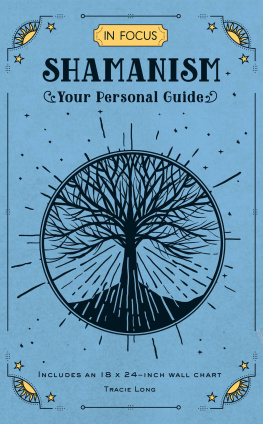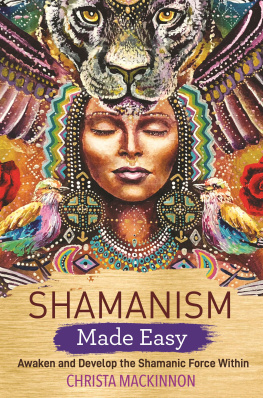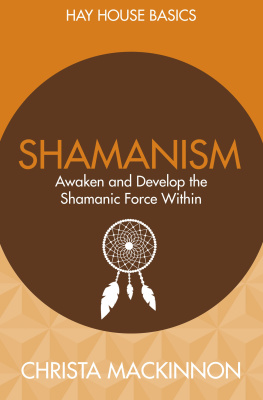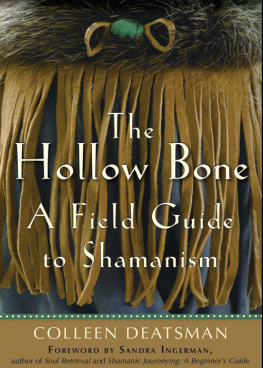Copyright 1996 by Tom Cowan
All rights reserved.
Published in the United States by Crossing Press, an imprint of the Crown
Publishing Group, a division of Random House, Inc., New York.
www.crownpublishing.com
www.tenspeed.com
Crossing Press and the Crossing Press colophon are registered trademarks of Random House, Inc.
Library of Congress Cataloging-in-Publication Data
Cowan, Thomas Dale.
Shamanism as a spiritual practice for daily life / by Tom Cowan.
p. cm.
1. New Age movement. 2. Shamanism. 3. Spiritual lifeNew Age movement I. Title.
BP605.N48C685 1996
299.93dc20
96-22341
ISBN 9780895948380
eBook ISBN: 978-0-8041-5235-8
v3.1
This book is dedicated to Tom Dowries, Lorenza Menegoni,
Phyllis Curott, Rodger Parsons, and the Drum we used to
sit around in Brooklyn.
Many people helped bring this book into being. I wish to thank Susan Lee Cohen, my agent, for keeping faith in the project; Joy Oliveira Steltzner, Maura Shaw, Sarah Wiehe, and Cait Johnson for reading the manuscript and courageously making important suggestions; Brooke Isberg for making me tell her how the book was coming along; Linda Gunnarson, my editor, for taking on the project with great enthusiasm; Kathy Glass for her wise copyediting; Jack Maguire for daily help and for his own inspiring spiritual practice; and last but not least, Peg Elliot Mayo, who flicked a switch and there was light.
PREFACE
A friend who is an authority on mystery traditions once asked me, Why would anyone in his right mind want to learn shamanism at a weekend workshop? She was thinking about the classic initiations into shamanism among tribal people in which, as she put it, youre sitting quietly in your yurt, minding your own business, when suddenly a hideous four-headed spirit monster blasts its way through the door flap, grabs you by the neck, yanks you up through the smoke-hole into some dreary realm, where it proceeds to slap you around, rip you apart, dip you in a foul-smelling gook, staple you back together again, and drop you back through the smoke-hole. Then it says, There! Now youre a shaman!
I had to agree with her. If thats the initiation into shamanism, who needs it? It doesnt sound like a very pleasant way to spend a weekend, much less one you have to pay money for. Fortunately, this classic description of being introduced to shamanism, found in many indigenous cultures in some form or another, is not the only way. Consider the story of Aua, an Eskimo-Iglulik shaman.
At his birth, Aua was apparently lifeless, with the umbilical cord wrapped around his neck, but Ardjuaq, a shaman from a nearby village, predicted that the young baby, lying beside its mother, would become a great shaman. He is born to die, but he shall live, she prophesied. Throughout his life, the boys family strictly observed the appropriate rituals and taboos to assure his continued health and to prepare him to become a shaman. Aua grew to adulthood, married, had four children, and lived the life of an average man in his tribal community, hunting and fishing, but always observing the ancient rituals and lifeways proper for a candidate for shamanhood. But the calling eluded him.
Aua visited elder shamans, offered gifts, and beseeched them to train him, but to no avail. They gave his gifts away and left Aua on his own. As he explained, I endeavored to become a shaman by the help of others; but in this I did not succeed. Frustrated, Aua eventually sought the silence and solitude of the wilderness, fell into a dark melancholy, wept copiously, and tried to understand the source of his perpetual unhappiness.
Then one day, something shifted. As Aua relates, I felt a great, inexplicable joy, a joy so powerful that I could not restrain it, but had to break into song, a mighty song, with only room for the one word: joy, joy! This was the turning point in Auas spiritual journey. In the midst of such a fit of mysterious and overwhelming delight I became a shaman, not knowing myself how it came about. But I was a shaman. I could see and hear in a totally different way. I had gained my enlightenment, the shaman-light of brain and body I could see through the darkness of life!
And the same light shone out from Aua, imperceptible to human beings, but visible to all the spirits of earth and sky and sea, and these now came to me and became my helping spirits. He said, I felt such a power of vision that I could see right through the house, in through the earth and up into the sky. To help him with these visions, Aua relied on his two primary spirits. One was a shore spirit, whom he perceived as a small woman, bright and cheerful and resembling a sweet little live doll the length of a mans arm. The other was a shark,
The search for a spiritual practice can be confusing because ultimately we are seeking a path for the soul, and the souls true journey through life often lies hidden in the shadowy landscape just beneath conscious awareness. As modern Westerners, we may have only a tenuous connection with our souls to begin with, since so much of our culture and way of life either ignores the souls deepest longings or offers a hostile environment for nurturing an intimate relationship with the soul. We perceive glimpses, whispers, and slight intimations about our souls vital needs, but we are often completely lost when it comes to finding the direction the soul needs to travel.
Many of us spend years stumbling through the darkness, searching for the light and joy of life. We blunder along, waiting for the light to shine, trying to remain faithful, open, and ready to respond. But in spite of all our efforts, the place, the timing, and the occasion of enlightenment are often determined by forces greater than our own.
On his journey from birth to shamanhood, Aua encountered many wrong turns, detours, and dead ends; yet he sensed throughout his long years of preparation and waiting that his true destiny was to walk the shamans path. Aua is not unlike many men and women in other cultures, including our own, who recognize, sometimes early in life, sometimes later, a strong vocation or calling to lead a certain type of spiritual life in spite of numerous stumbling blocks that lie in the way. Worldly distractions, wrong advice, lack of support from others, and the unwillingness to make the necessary changes to lead a truly spiritual life prevent us for many years from finding our path. Then at some mysteriously proper moment, the sky brightens, and we see the truth: that we are on it. And like Aua, we are swept with joy.
Shaman is a Tungus word from Central Asia referring to a person who uses a state of spiritual excitement to enter the normally imperceptible realities of the spirit world to get help for him- or herself or others. But students of language disagree over the exact etymology of the word. Where does it come from? What was its original meaning? What ancient practices or rituals inspired this mysterious word shaman, which still has the power to make us tingle?
Among the early rootwords from which shaman may have been derived are words for knowledge and heattwo ideas that capture fully the rich traditions of classic shamanism and its modern counterparts. The shaman is someone on fire with certain kinds of knowledge that come from the spirit world. In any era, the practice of shamanism puts one on the path that leads to a growing awareness of the spiritual mysteries of the universe.
At the heart of shamanism are the controlled visionary experiences that connect the practitioner with the spiritual beings who guide, guard, instruct, and bless his or her life. In traditional shamanism these personal spirits are unique to each tribal culture; in modern core shamanism the spirits are personal and unique to each practitioners private spiritual experience, background, and belief system.










